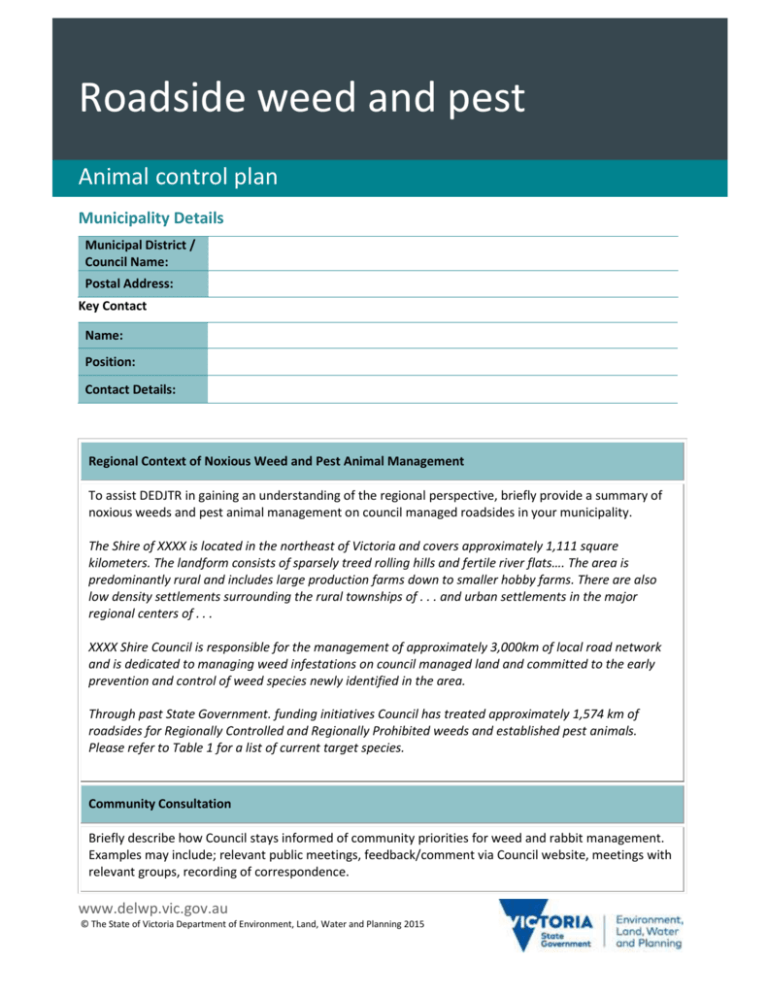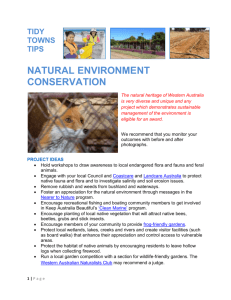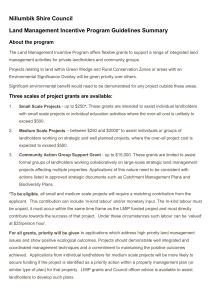Municipality Details Municipal District / Council Name: Postal
advertisement

Roadside weed and pest Animal control plan Municipality Details Municipal District / Council Name: Postal Address: Key Contact Name: Position: Contact Details: Regional Context of Noxious Weed and Pest Animal Management To assist DEDJTR in gaining an understanding of the regional perspective, briefly provide a summary of noxious weeds and pest animal management on council managed roadsides in your municipality. The Shire of XXXX is located in the northeast of Victoria and covers approximately 1,111 square kilometers. The landform consists of sparsely treed rolling hills and fertile river flats…. The area is predominantly rural and includes large production farms down to smaller hobby farms. There are also low density settlements surrounding the rural townships of . . . and urban settlements in the major regional centers of . . . XXXX Shire Council is responsible for the management of approximately 3,000km of local road network and is dedicated to managing weed infestations on council managed land and committed to the early prevention and control of weed species newly identified in the area. Through past State Government. funding initiatives Council has treated approximately 1,574 km of roadsides for Regionally Controlled and Regionally Prohibited weeds and established pest animals. Please refer to Table 1 for a list of current target species. Community Consultation Briefly describe how Council stays informed of community priorities for weed and rabbit management. Examples may include; relevant public meetings, feedback/comment via Council website, meetings with relevant groups, recording of correspondence. www.delwp.vic.gov.au © The State of Victoria Department of Environment, Land, Water and Planning 2015 It is expected that prior to drafting the plan, Council will have notified the community that a plan is to be prepared and views are invited on what the plan should address. Views from the community should be considered. The XXX Shire Environment Officer stays in close touch with community concerns via attendance at meetings of [landcare or other groups] and via phone calls and correspondence from individuals. The Shire has also specifically requested community views on this issue via [local newspaper, council newsletter, radio interviews] and maintains a record of feedback. Much of the information required to develop this plan had already been obtained during development of the XXX Shire [relevant existing plans or strategies]. Stakeholder Consultation List key stakeholders who have been consulted in the development of this plan. John Deere, Biosecurity Area Leader, DEDJTR Luke Waters, Landcare Coordinator, Upper Reaches Landcare Network Rebecca Green, Catchment Planning Officer, North East Catchment Management Authority Relevant Local, Regional Policies and Strategies and submissions List policies, strategies and submissions relevant to this plan. State Invasive Plants and Animal Policy Framework Regional Upper Reaches CMA Regional Weed Plan Local XXXX Shire Council’s Environment Strategy (Action 3.2.1) XXXX Shire Council’s (Draft) Weed Management Plan 2012 – 2017 XXXX Shire Council’s Invasive Animals Strategy 2010 – 2015 XXXX Shire Council’s Roadside Management Plan Submissions Any submissions received by Council relating to RPWs, RCWs, EPAs or Restricted Weeds. Objectives of the Plan Provide a general overview of Council’s objectives, activities, outputs and expected outcomes. Contribute to the Shire’s ongoing roadside weed and rabbit management program and complement past investments made by XXXX Shire enabled through State Government initiative funding. Assist with preventing the spread and introduction of invasive plant and animal species across the Shire and the region as a whole. XXXX Shire Council’s overall roadside weed and rabbit management objective is the effective and proactive management of invasive species on Council managed roadsides across the Shire. Investment of funds will be aligned to: 1. Treatment for the eradication of Regionally Prohibited Weed infestations. 2. Treatment for the containment or reduction in area infestations of Regionally Controlled Weeds and rabbits – aligned to DEDJTR weed and rabbit compliance project area. 3. Supporting community group investment in weed and pest control projects. 4. Contributing to other previous investment in the control of Regionally Controlled and Regionally Prohibited Weeds and rabbits. 5. Protect identified assets such as significant roadside vegetation under threat from weed invasion or other significant roadside infrastructure. 6. Support weed and pest animal management programs being undertaken by land owners. 7. Addressing other roadside declared noxious weed infestations of concern to the Shire’s community including Restricted Weeds declared under the Catchment and Land Protection Act 1994 (CaLP Act). [list any relevant local examples] Term of Plan Outline the term for which the plan is to operate. The plan will run for a two year period from 1 July 2015 (date of commencement) to 30 June 2017 Funding Outline how council plans to fund the implementation of the plan. RWPP Allocation - $XX,XXX per year Council Contribution - $XX,XXX per year Other funding. Table 1: Target Species Outline the target species and reasoning for management. Common Name Scientific Name CaLP classification PRIORITY RATING (1 highest – 4 lowest) Reasons for Management Rabbit Oryctolagus cuniculus Established Pest Animal 1 - To support community and stakeholder action. Blackberry Rubus fruticosus (agg.) Regionally Controlled Weed 1&2 - To support DEDJTR compliance programs. Sweet Briar Rosa rubiginosa Regionally Controlled Weed 3 - In response to frequent ratepayer requests, support community and stakeholder action. Boneseed Chrysanthemoides monilifera Regionally Prohibited Weed 1 - To support previous investment by Council Serrated tussock Nassella trichotoma Regionally Prohibited Weed 1 - To support DEDJTRcompliance programs Bridal Creeper Asparagus asparagoides Restricted Weed - In response to frequent ratepayer requests, support community and stakeholder action. 4 Table 2: Control Measures and Target Roadsides Outline control techniques and additional details. Location of where works will be done (location of proposed works should be specified, and a map where possible should accompany the plan) Control Measures (to be based on accepted best practice management of the target species) Common Name* Rabbit - Mechanical ripping of warrens - Blackberry - Spot spray application of a registered herbicide in accordance with the product label Mechanical removal where herbicide application is inappropriate Spot spray application of a registered herbicide in accordance with the product label Spot spray application of a registered herbicide in accordance with the product label Cut-stump herbicide application Manual removal of seedlings Spot spray application of a registered herbicide in accordance with the product label Manual removal of isolated plants - Sweet Briar - Boneseed - Serrated tussock - - - Estimate of length of roadside to be treated annually over 3 years (Km = length of road along which both sides are treated. Where only one side is treated halve the figure) Approximate Annual Timing of Treatment Predominantly on Sutton Rd and Hughes Rd Predominantly on Newton Rd and Chalk St 200km Sept - Feb 30km Nov - Feb Predominantly on Ferry St Predominantly on Newton Rd and Chalk St 6km Nov - Feb 5km Jun – Oct 5km All year Feb – Oct Predominantly on Ferry St All year * Where multiple noxious weeds are to be treated simultaneously in the same locations, only the most common weed species needs to be listed. Estimated Cost Maps Map 1 Proposed location of control works. Map 2 Known infestations of Regionally Prohibited Weeds, Regionally Controlled Weeds and Established Pest Animals and Restricted Weeds. Statement of Responsibilities Council will: Publish this approved plan (or approved variation to this plan if relevant) on its website within 28 days of approval and ensure copies are available for public inspection at Council’s office/s. Coordinate the implementation of this plan on Council managed roadsides in accordance with the investment principles stated in this plan and the control measures specified in Table 2. Implement best practice weed hygiene principles and protocols. Maintain accurate records sufficient to provide evidence that the plan has been carried out and provide these to DEDJTR on request. Obtain approval from DEDJTR before substantially modifying or varying the plan. Carefully consider any proposals from DEDJTR to modify or vary the plan in response to changed circumstances. Provide a completion report to DEDJTR within 30 days from expiry of this plan outlining the outcomes of the control measures undertaken. Declaration I declare that I am an authorised representative and the information given on this form is complete and correct. Key contact Name: Date: Signature: Council CEO Name: Signature: Date:





